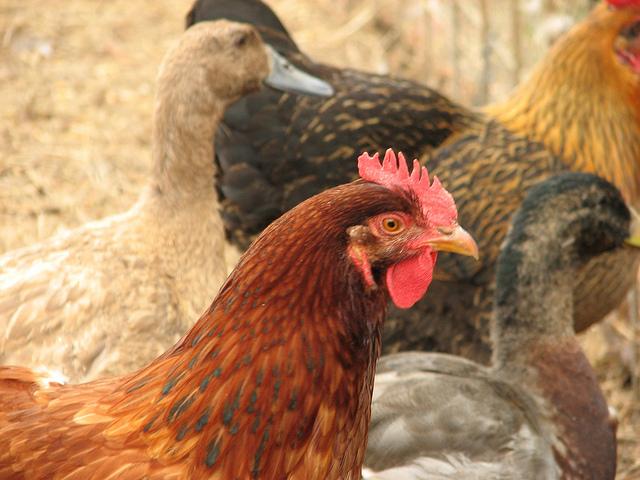Taiwan yesterday reported another nine outbreaks of highly pathogenic H5N8 and H5N2 avian influenza, forcing the destruction of more than 80,000 poultry.
In addition, US authorities said the H5N2 virus that cropped up on turkey farms in Missouri and Arkansas this week is a close match for the virus that struck in Minnesota last week and was found in a wild bird in Washington state in December.
Also, in a stroke of apparent catch-up reporting, South Korea today described 47 H5N8 outbreaks that all occurred last year, forcing the destruction of more than half a million poultry. Earlier this month South Korean authorities reported 65 H5N8 outbreaks that dated from September 2014 to January of this year.
Taiwan events
Taiwan, which has battled numerous H5N8 and H5N2 outbreaks this year, was hit by three H5N8 outbreaks in Yunlin and Pingtung counties, in the southern and southwestern parts of the island, according to a report authorities filed with the World Organization for Animal Health (OIE).
Of 30, 250 chickens and geese on the affected farms, 15,987 died of the infection, and the rest were destroyed to stifle any further spread, the report said. All three outbreaks started within the first 5 days of March.
In a separate report, Taiwan officials described six H5N2 outbreaks that hit goose, duck, and chicken farms in four counties—Yunlin, Hsinchu, Changhua, and Chaiyi—in late February and early March. The outbreaks killed 15,363 birds, and the remaining 35,327 birds were culled to arrest the virus, the report said. The affected counties are in western and northwestern Taiwan.
South Korea catch-up report
In South Korea's report to the OIE today, officials profiled a cluster of 40 H5N8 breaks in the centrally located North Cheongchung province, plus seven other outbreaks scattered around the country. It said the outbreaks occurred in February, May, June, and July of 2014, but did not explain why they were not reported earlier.
The sites involved in the 40-outbreak cluster had a total of 458,735 ducks and ostriches, the report said. Only 1,500 birds were sickened by the virus, but the rest were all culled, it said.
In all, the 47 sites involved in the outbreaks had 544,902 poultry, and 544,877 were culled, according to the report. Information on case numbers was lacking for all but one of the outbreaks that were not part of the cluster.
Missouri, Arkansas viruses match Washington one
In other news, the US Department of Agriculture (USDA) found that the H5N2 viruses that struck turkey farms in Missouri and Arkansas this week were more than 99% similar to the isolate found in a northern pintail duck in Washington state in December, as determined by partial genetic sequencing.
The USDA reported the finding in an OIE report posted yesterday. It signaled that the Missouri and Arkansas viruses matched well with the H5N2 virus that hit a Minnesota turkey farm earlier this month, because the USDA had said earlier that the Minnesota virus closely matched the pintail duck isolate.
The report also detailed the poultry death tolls in the Missouri and Arkansas outbreaks. It said the virus killed 3,260 of 23,000 turkeys on the farm in Moniteau County, Mo., 1,925 of 30,100 turkeys at the site in Jasper County, Mo., and 1,766 of 20,020 turkeys on a farm in Boone County, Ark. The surviving turkeys in all the flocks were destroyed.
The report also mentioned the detection of H5N2 in a hunter-killed Canada goose in Jefferson County, Wash.
Minnesota birds test negative
And in another related development, a red-tailed hawk that was found dead in southeastern Minnesota has tested negative for the H5N2 virus, according to Hon Ip, PhD, MS, of the US Geological Survey's National Wildlife Health Center in Madison, Wis. The center has invited the submission of wild birds that were found dead so that they can be tested in the hunt for the cause of the Midwestern H5N2 outbreaks.
The hawk was found in Olmsted County in southeastern Minnesota. Ip told CIDRAP News today that avian flu levels in wild birds are typically low at this time of year. "The lack of detection in Minnesota is consistent with what we normally would expect. It just doesn't help us in terms of finding out how the Pope County [Minn.] facility got infected," he said.
In an update yesterday, the Minnesota Board of Animal Health (MBAH) said backyard birds on 30 sites within the 10-kilometer-radius control zone around the affected Minnesota turkey farm all tested negative for the virus. The birds remain under quarantine for further observation.
See also:
Mar 12 Taiwan OIE report on H5N2 outbreaks
Mar 12 Taiwan OIE report on H5N8 outbreaks
Mar 13 South Korea OIE report on 47 H5N8 outbreaks
Mar 12 USDA OIE report on Missouri and Arkansas outbreaks
Mar 12 MBAH update
Related Mar 5 CIDRAP News story





















